Rainbowfish are popular among hobbyists for obvious reasons: They are colorful, lively, peaceful, and easy to care for. As a bonus, these fish also have a preference for aquariums that are well-decorated. Gorgeous fish, stunning aquascape… There’s nothing else a hobbyist can ask for!
If we’ve convinced you to consider adding rainbowfish to your freshwater tanks, read on! This article explores 15 types of rainbowfish that may someday find a home in your tank. There’s bound to be something for everyone!
15 Beautiful Rainbowfish
1. Banded Rainbowfish
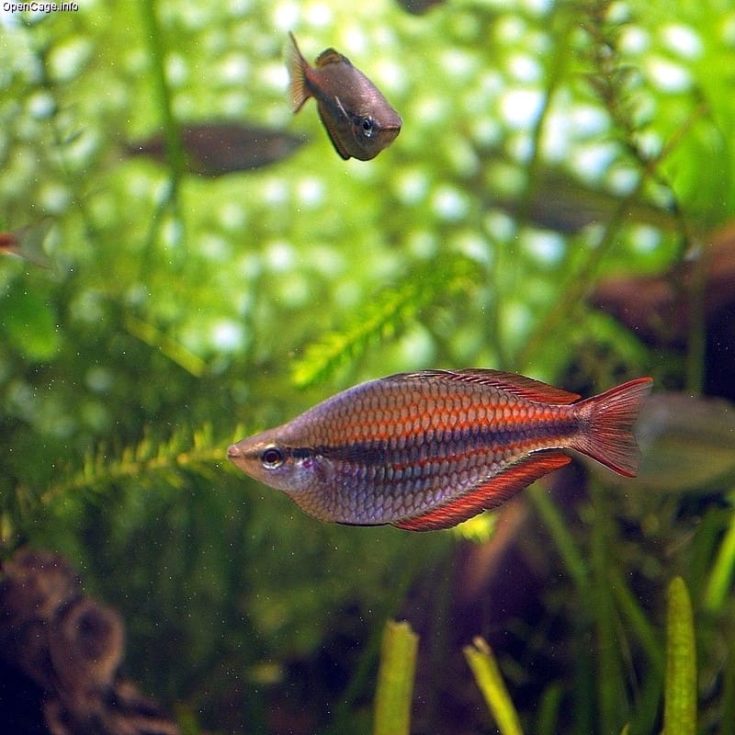
Scientific Name: Melanotaenia trifasciata
Adult/Max Size: Up to 5.1 inches
Diet: Omnivores
Care Level: Beginner
Aptly named for the thick black band that runs down the length of its body, the banded rainbowfish dazzles with its myriad of colors. These colorful fish are available in red, blue, green, purple, and yellow.
In the wild, these fish can typically be found in rivers, lakes, lagoons, and swamps with dense vegetation. Therefore, they are most at home in a large planted tank. As is often the case with planted tanks, slow-moving waters create the ideal conditions for both your fish and the plant.
Banded rainbowfish are not fussy eaters and will be perfectly content with flakes purchased from your local store. However, supplementing their diets with live sources of protein, such as brine shrimp often results in a more vibrant coloration.
2. Boesemani Rainbowfish
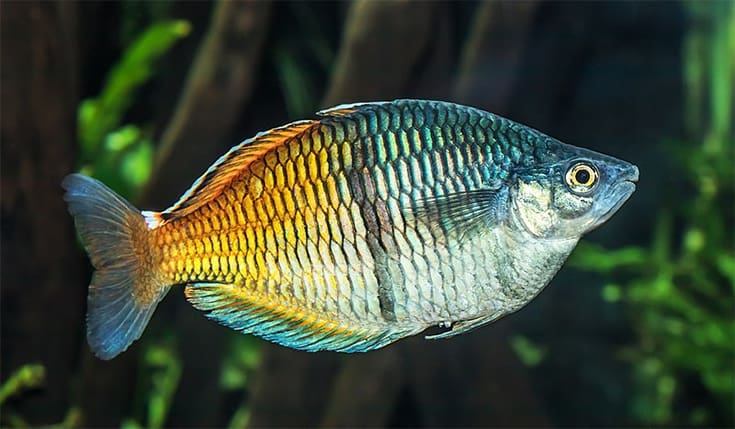
Scientific Name: Melanotaenia boesemani
Adult/Max Size: Up to 4 inches
Diet: Omnivores
Care Level: Beginner
Originally found in the waters of Indonesia, Boesemani rainbowfish have a preference for the tropical conditions of their natural habitat. This means that your water should be kept at a temperature of 81-86°F, with a relatively neutral pH level between 7.0 and 8.0.
Although these are generally peaceful fish, hobbyists should still be thoughtful when it comes to tank mate selection. Boesemani rainbowfish are relatively large fish that swim quickly, which can stress smaller, more docile tankmates out.
Appearance-wise, these fish are as striking as you would expect. Its head is composed of cool colors such as blues, greens, and purples, while its rear is a stunning red, orange or yellow.
3. Crimson-Spotted Rainbowfish
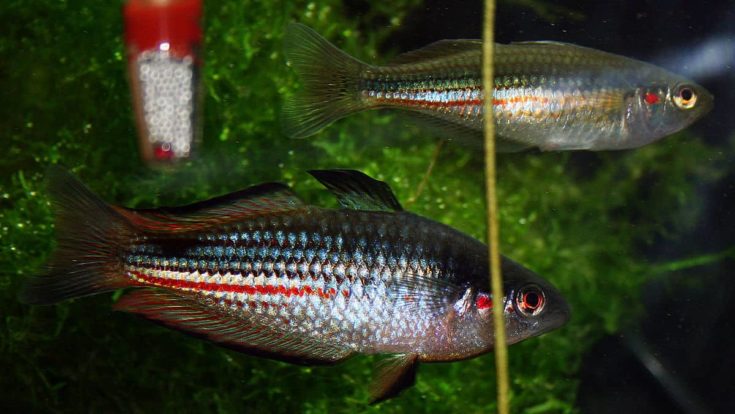
Scientific Name: Melanotaenia duboulayi
Adult/Max Size: Up to 4.7 inches
Diet: Omnivores
Care Level: Beginner
Sometimes known as Duboulay’s rainbowfish, the crimson-spotted rainbowfish got its name from the distinctive red spot located on its operculum, as well as the flecks of red and orange that line its body.
One particularly notable feature lies in the fact that they have two dorsal fins located close to one another. The first dorsal fin, located closer to its head, is considerably smaller than the second dorsal fin, which extends to the end of its body.
In its native home of Australia, crimson-spotted rainbows are often released into swamps and rivers as they are excellent at mosquito control.
4. Checkered Rainbowfish
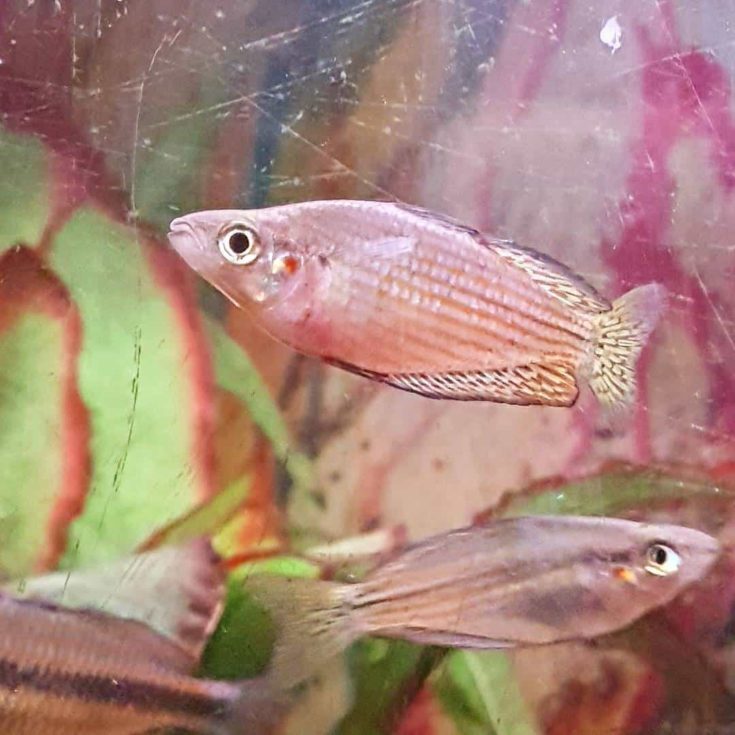
Scientific Name: Melanotaenia splendida inornata
Adult/Max Size: Up to 4.7 inches
Diet: Omnivores
Care Level: Beginner
As its name suggests, the body of the chequered rainbowfish is adorned by horizontal stripes lined up next to rows of scales. This distinctive pattern cuts across its colorful body, which is silvery blue towards the top and iridescent pink at the bottom.
Though these fish are technically omnivores, the vast majority of their diet should be composed of algae-based food. You may consider supplementing its diet with live sources of protein such as brine shrimp and bloodworms.
Today, these gorgeous fish are widely found in fish stores. It can still be widely found in its native home of Northern Australia.
5. Neon Rainbowfsh
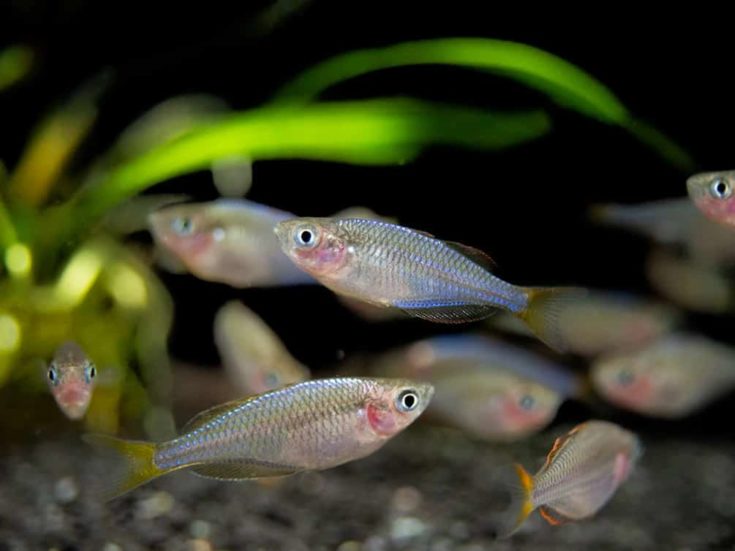
Scientific Name: Melanotaenia praecox
Adult/Max Size: Up to 2.5 inches
Diet: Omnivores
Care Level: Intermediate
As one of the smallest entries on our list, the neon rainbowfish is gorgeous but not recommended for beginners. Although they get along with other fish, these fish can be finicky and are sensitive to water changes.
Once they’ve established themselves in your freshwater tank, however, the neon rainbowfish is an absolute delight. These fish thrive in schools of 10 or more and are active swimmers that will dazzle with their neon blue and green coloration.
6. Desert Rainbowfish
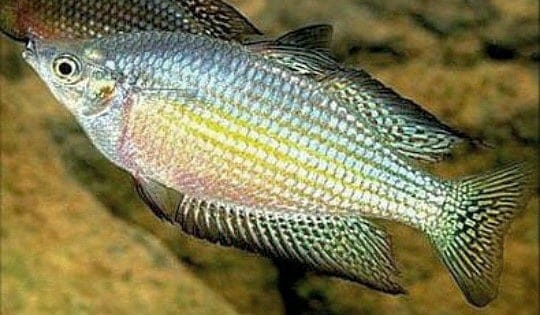
Scientific Name: Melanotaenia splendida tatei
Adult/Max Size: Up to 4 inches
Diet: Omnivores
Care Level: Intermediate
Gorgeous as they may be, the desert rainbowfish are rarely found outside their native homeland of Australia. These striking fish come in 3 colorations: Females are silvery-white with clear fins, while males are either purple with green fins, or an ethereal shade of bluish-green throughout.
If you do manage to get your hands on one of these unique fish, you should attempt to replicate the climate and conditions found in Central Australia. These are highly adaptable fish that can withstand temperature fluctuations. However, they are happiest in water that is between 75 and 86 °F.
7. Lake Kutubu Rainbowfish
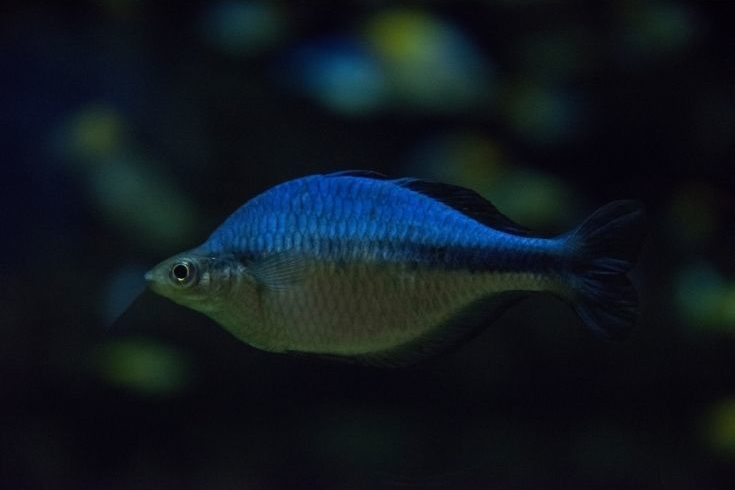
Scientific Name: Melanotaenia lacustris
Adult/Max Size: Up to 5 inches
Diet: Omnivores
Care Level: Intermediate
As one can easily surmise, Lake Kutubu Rainbowfish originate from the calm waters of Lake Kutubu, located in Papua New Guinea. These fish are known for their deep blue, yellow and turquoise coloration. Male fish tend to have more vibrant color compared to their female counterparts, though fish of both genders can easily stand out in a crowd.
These fish are active swimmers that enjoy shoaling. This makes them a real sight to behold as they avidly roam their tanks!
8. Lake Wanam Rainbowfish
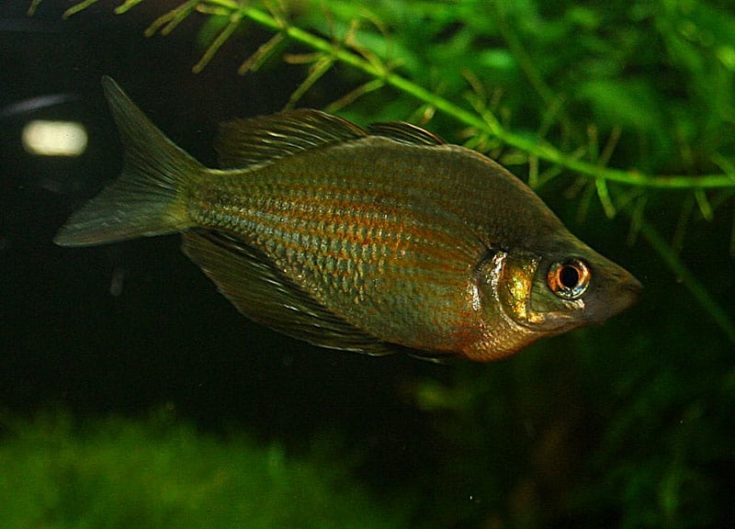
Scientific Name: Glossolepis wanamensis
Adult/Max Size: Up to 4 inches
Diet: Omnivores
Care Level: Advance
The Lake Wanam Rainbowfish is in a unique but unfortunate predicament. Though they are native to Lake Wanam in Papua New Guinea, these fish have virtually disappeared from their homes. As such, they are classified as a critically endangered species.
These fish are distinguished by their colorful bodies and clear, long, dorsal fins. These fish are beautiful, but require pristine water conditions. Hobbyists who are up for the challenge might be able to find these fish sold by specialized breeders. Just be sure to check that your fish hasn’t been cross-bred with a similar species!
9. Madagascar Rainbowfish
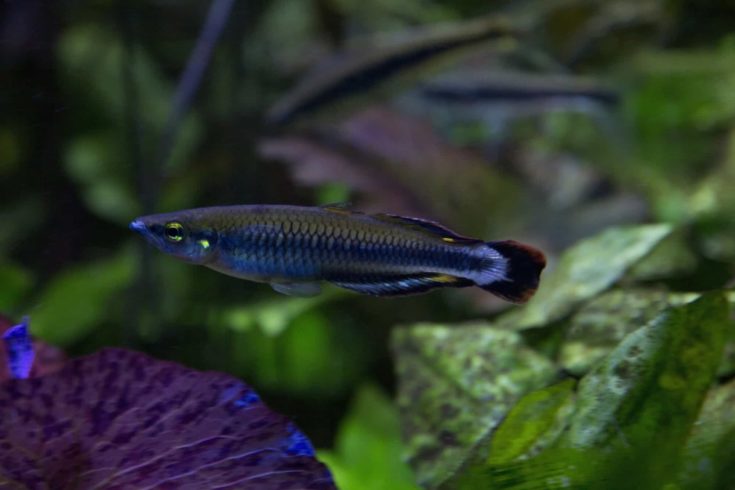
Scientific Name: Bedotia madagascariensis
Adult/Max Size: Up to 4 inches
Diet: Omnivores
Care Level: Beginner
The Madagascar rainbowfish is distinguished by it’s colorful fins and tail. These fish have bodies that are silvery-grey, while it’s fins are tinged with red and black. To bring out their unique coloration, it is generally best to house them in tanks that are well planted.
In addition, hobbyists should keep in mind that these fish thrive in schools of 8 to 10, which will also make for a more natural-looking display. Though these fish are peaceful, they can be intimidating to smaller fish. Tankmates should be composed of fish that are peaceful yet confident, such as similarly-sized catfish.
10. Murray River Rainbowfish
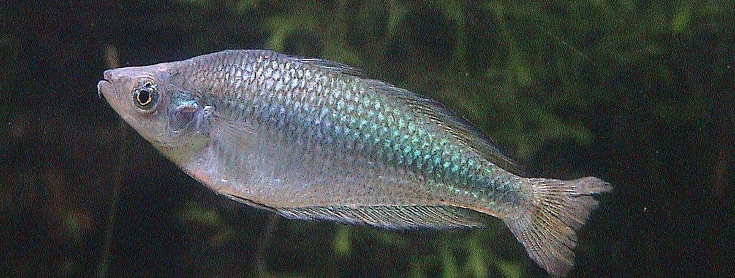
Scientific Name: Melanotaenia fluviatilis
Adult/Max Size: Up to 4.3 inches
Diet: Omnivores
Care Level: Beginner
Also known as the Australian rainbowfish, the Murray River rainbowfish have silvery-green scales marked by a brown outline. Meanwhile, their fins are a striking combination of yellow and red. Male fish have bright orange stripes located close to their rears.
Like most rainbowfish, the Murray Rivers are rather laid-back when it comes to their diet. In the wild, they eat anything from mosquito larvae to algae. In captivity, they are content with most types of flake food.
11. Red Rainbowfish
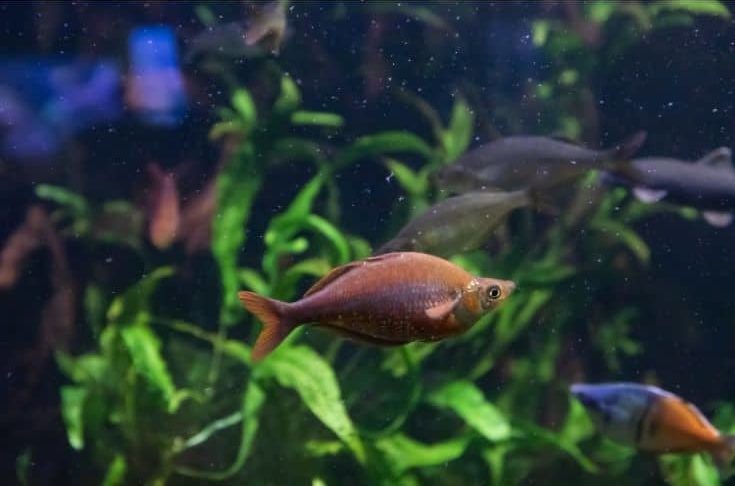
Scientific Name: Glossolepis incises
Adult/Max Size: Up to 6 inches
Diet: Omnivore
Care Level: Beginner
Behold – the first Southeast Asian rainbowfish on our list! Originating from Indonesia, the red rainbowfish is perfect for beginners. These resilient fish are peaceful and friendly, making them ideal choices for amateurs and novices alike.
These fish enjoy shaoling in groups of 8-10. Most hobbyists will want male fish to make up at least half of the overall population, as they are the ones bearing red coloration on their bodies. Female fish and juveniles are brown in color.
Because these fish hail from a region that is close to the equator, they are accustomed to warm waters. Be sure to keep your water at a comfortable 70°F-79°F!
12. Axelrod’s Rainbowfish
Scientific Name: Chilatherina axelrodi
Adult/Max Size: Up to 3.9 inches
Diet: Omnivore
Care Level: Beginner
Named after tropical fish expert Herbert Axelrod, the Axelrod rainbowfish is endemic to the Yungkiri stream in Papua New Guinea. They have a preference for conditions that imitate the gentle conditions of their habitat – this means slow-moving waters, a comfortable temperature of approximately 78°F and lots of hiding spaces.
As is often the case with rainbowfish, the male members of this species are blessed with a more colorful appearance. They have abdomens that are either bluish-green or greenish-brown in color, dotted by a series of short black bars on its flank.
This fish also makes a solid option for hobbyists hoping to breed their fish. However, do note that keeping its fry alive requires a considerable amount of effort!
13. Pacific Signifier
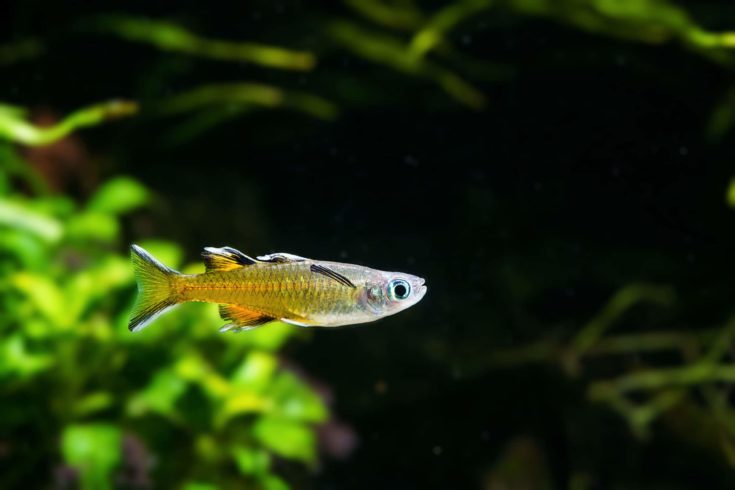
Scientific Name: Pseudomugil signifer
Adult/Max Size: Up to 3 inches
Diet: Omnivorous
Care Level: Beginner
What we love about the Pacific Signifier is that they are one of very few rainbowfish that can be kept with nano shrimp! While other fish may be large enough to prey on tiny sea creatures, the pacific signifier neither has the means nor the desire to do so. This means that these fish are friendly enough for most tank settings.
These fish are also sometimes known as the Pacific Blue Eye Signifer Rainbowfish, and it’s easy to see why. They have large, neon-blue eyes that stand out against their yellow and blue bodies.
14. Threadfin Rainbowfish
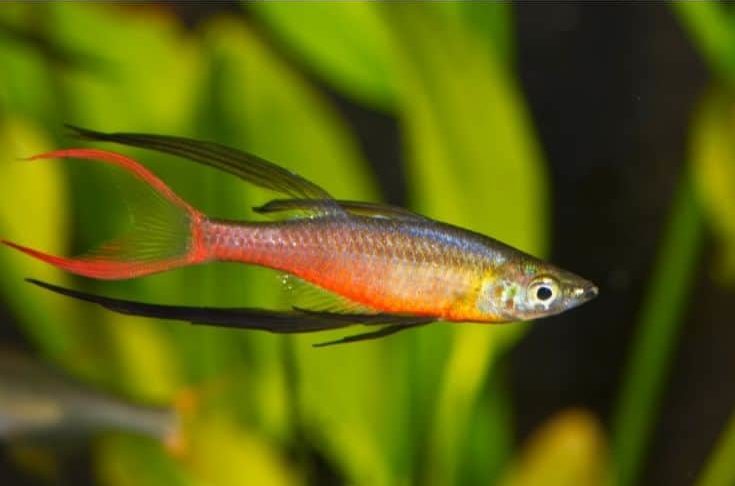
Scientific Name: Iriatherina werneri
Adult/Max Size: Up to 2 inches
Diet: Omnivorous
Care Level: Intermediate
It should come as no surprise that the threadfin rainbowfish has one of the most unique body shapes out there. Male members of this species have filament extensions on their dorsal fins, giving them an elegant look. In general, the bodies of these fish are silver, with black and red markings on their fins.
Because these fish are so tiny, it is important to keep them in schools to boost their confidence. While they are excellent community fish, they should be kept away from fin-nippers, who might be tempted to take a bite out of their flowing dorsal fins.
15. Eastern Rainbowfish
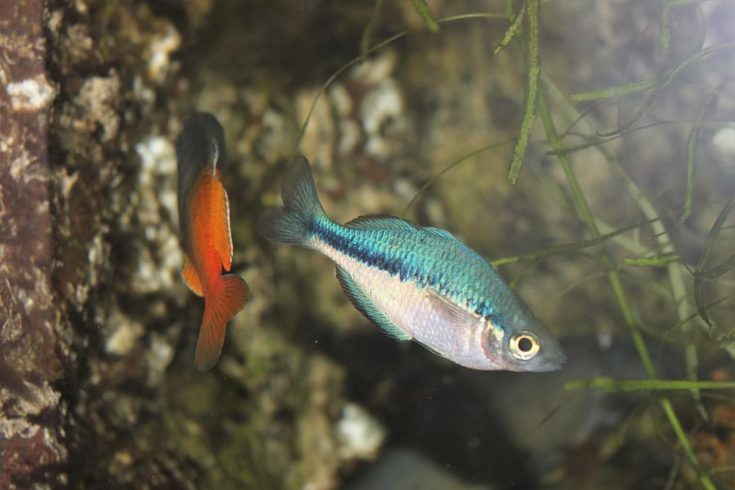
Scientific Name: Melanotaenia splendida splendida
Adult/Max Size: Up to 6 inches
Diet: Omnivore
Care Level: Intermediate
Like most of its peers, the Eastern rainbowfish benefits from being housed in a tank that is regularly cleaned. Though these fish appear hardy, they can be sensitive to fluctuations in water parameters. Hobbyists should perform a 30% water change weekly basis to keep their fish healthy.
These fish can be rather skittish if they lack a shoal. Therefore, it is important to always house at least 6 fish together. Do make sure that your tank contains adequate space for you to do so!
Conclusion
Keeping rainbowfish in an aquarium is extremely rewarding, and we hope you consider our suggestions! This is especially the case if you hope to keep a variety of fish in your tank – rainbowfish are perfect for this purpose.
Did you enjoy our article? If you did, please share it with someone else who might also find it useful and entertaining! Rainbowfish make marvelous pets – we can’t recommend it enough!
